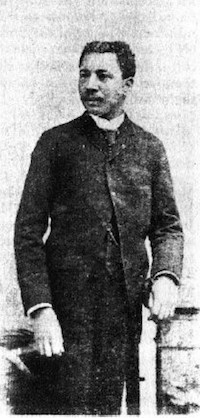
Concert pianist, composer, and music conservatory director José Manuel Jiménez Berroa was born on December 7, 1855, into a musical family in Trinidad, Cuba, a city on the central coast known for its mainly African-descended population, sugar mills, and tobacco production. His grandfather, Nicasio Jiménez Sr., was a part-time band conductor, and his father, José Julian Jiménez, had experienced moderate success as a violinist in Europe before returning home to form his own orchestra. As a boy, Manuel Jiménez took piano lessons from his aunt, Catalina Berroa Ojea, a distinguished organist. At age 12, Manuel Jiménez and his older brother Nicasio Jiménez Jr., a cellist, were sent to Hamburg, Germany, where they were tutored by George Armbrust, a professor at the city’s music conservatory and friend of Johannes Brahms. They were soon reunited with their father who fled Cuba’s political turmoil.
To survive in Europe, the Jiménez family was forced to earn money performing in assorted musical groups at various venues, eventually forming a touring music ensemble of their own that became popular in Europe between 1871 and 1875 called “Das Negertrio” (“The Negro Trio”) in Germany and “The Colored Trio” in England. By and large, European critics were quite receptive, judging their performances as virtuoso, graceful, and sensitive.
Confident in his abilities and with varied experiences under his belt, Manuel Jiménez launched his career as a concert pianist in 1874. Concurrently, he trained at the Leipzig Conservatory in Germany and then transferred to the Paris Conservatory where he was tutored by Antoine François Marmontel whose celebrated pupils included Georges Bizet, Isaac Albeniz, and Vincent d’Indy. In 1877 the “truly talented” Cuban won the coveted Prix de Rome competition for his performance of Schumann’s Sonata in G minor. Following this, he performed before Richard Wagner at his Villa Wahnfried in Bavaria and was befriended by the Hungarian composer Franz Liszt, whose works he most favored along with those of Frederic Chopin, Ludwig van Beethoven, Felix Mendelssohn, and Robert Schumann.
Returning to Cuba in 1879, Manuel Jiménez was hailed as a national hero for his triumphs in Europe. In between composing music for piano and tutoring students at his new home in Cienfuegos, he had a highly successful concert tours on the island beginning in Havana at the Gran Teatro de Tacón, and entertained delighted audiences in Central America and the West Indies. Still, the political and racial climate in Cuba convinced him to live permanently in Europe. By 1890 he had returned to the conservatory in Hamburg where he lived a quiet life as music professor with his German wife, Emma Filter, until his death on January 15, 1917.

